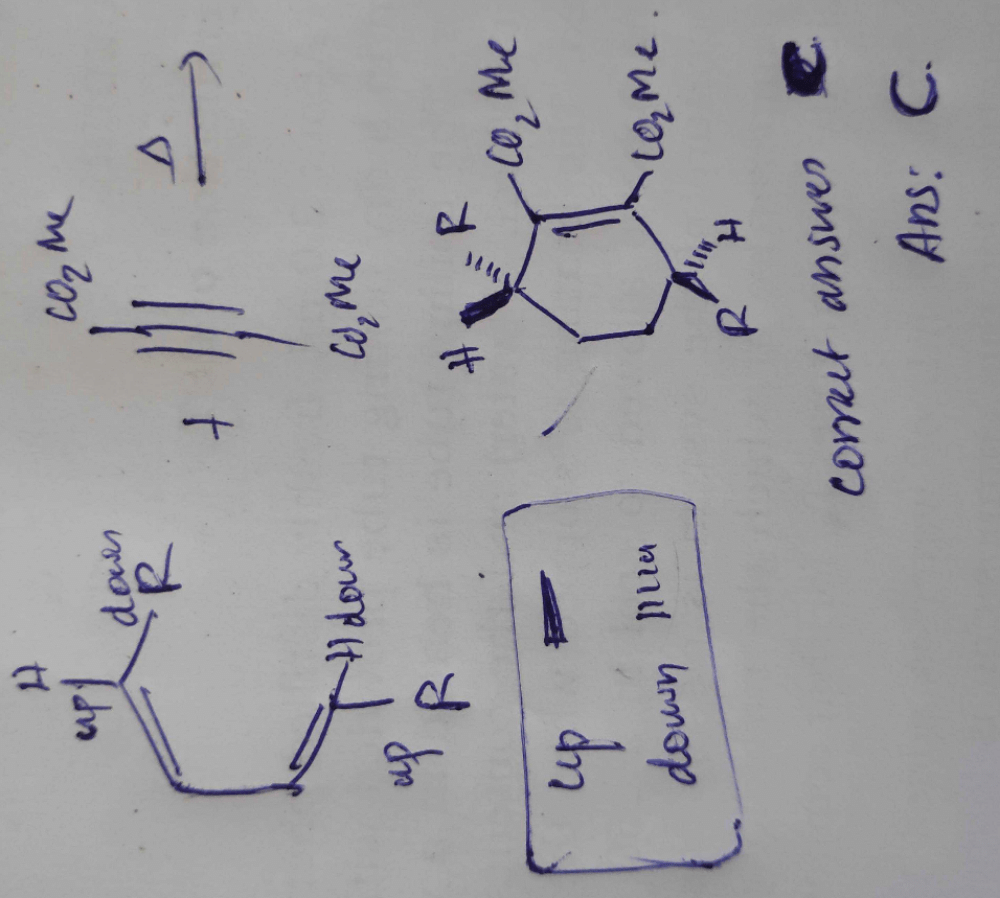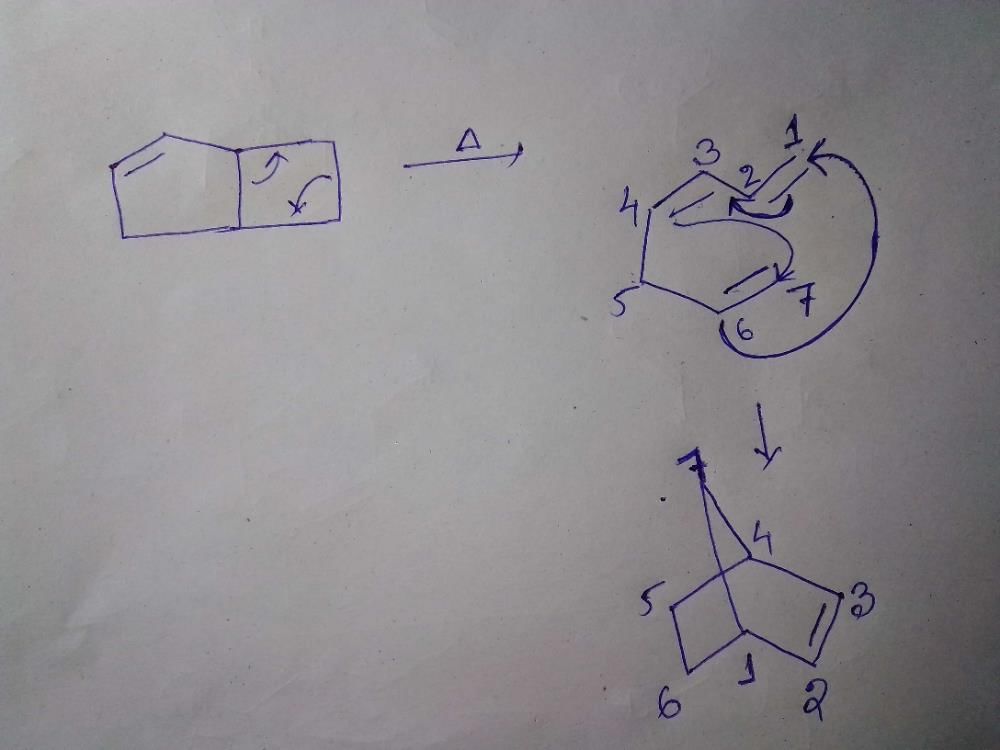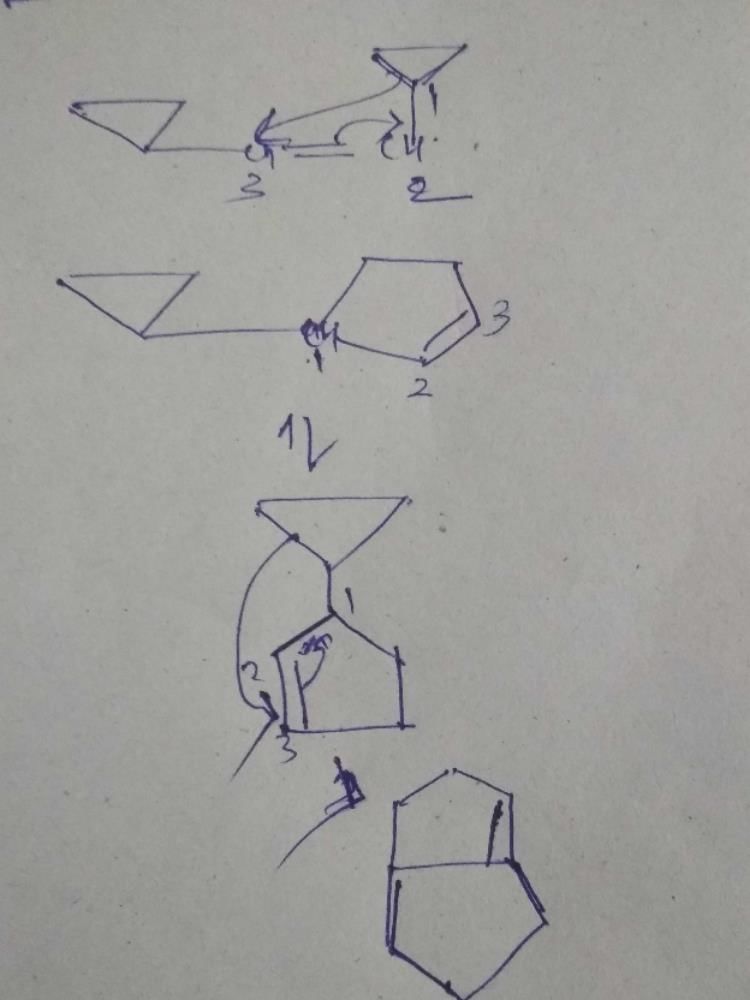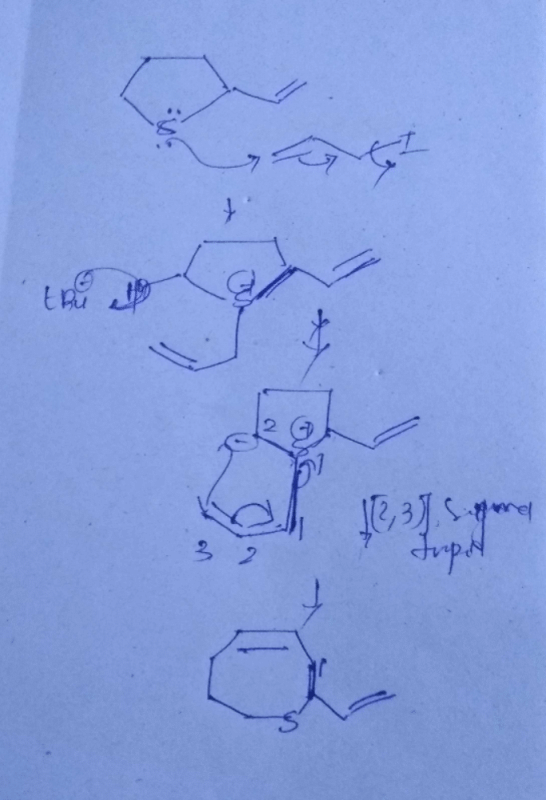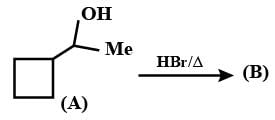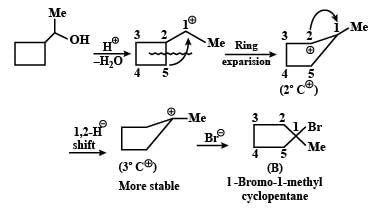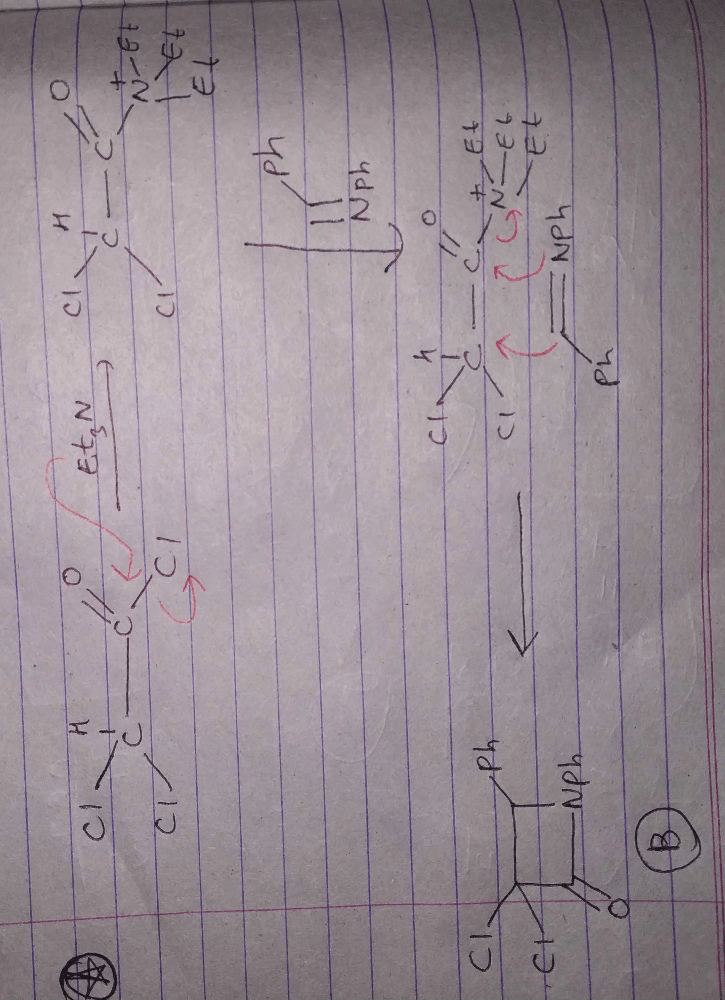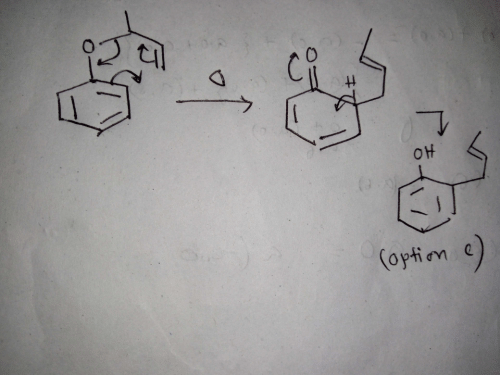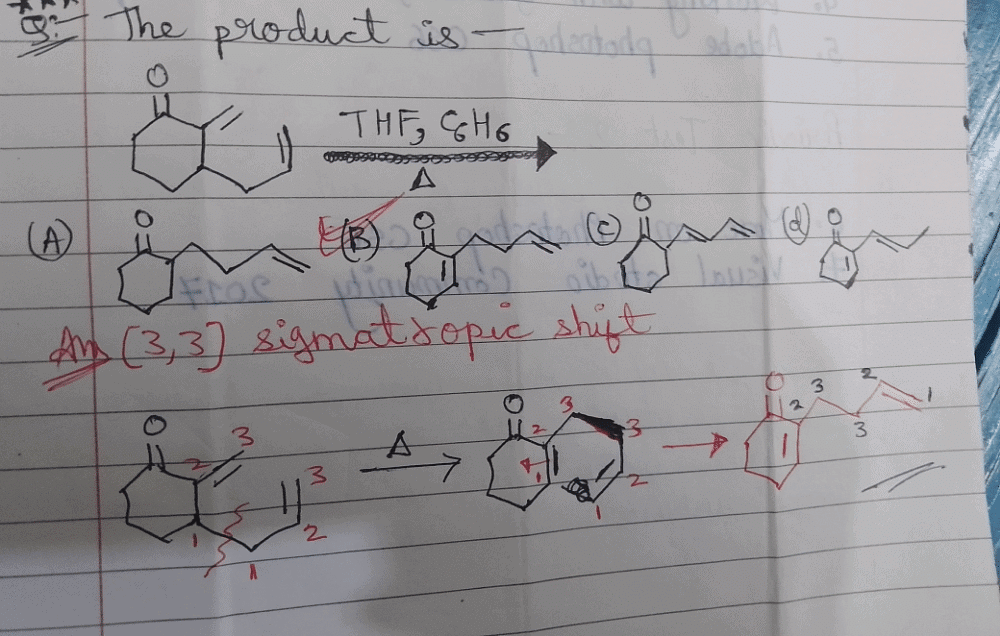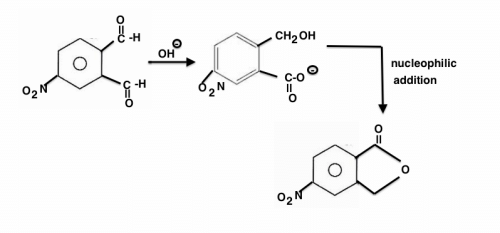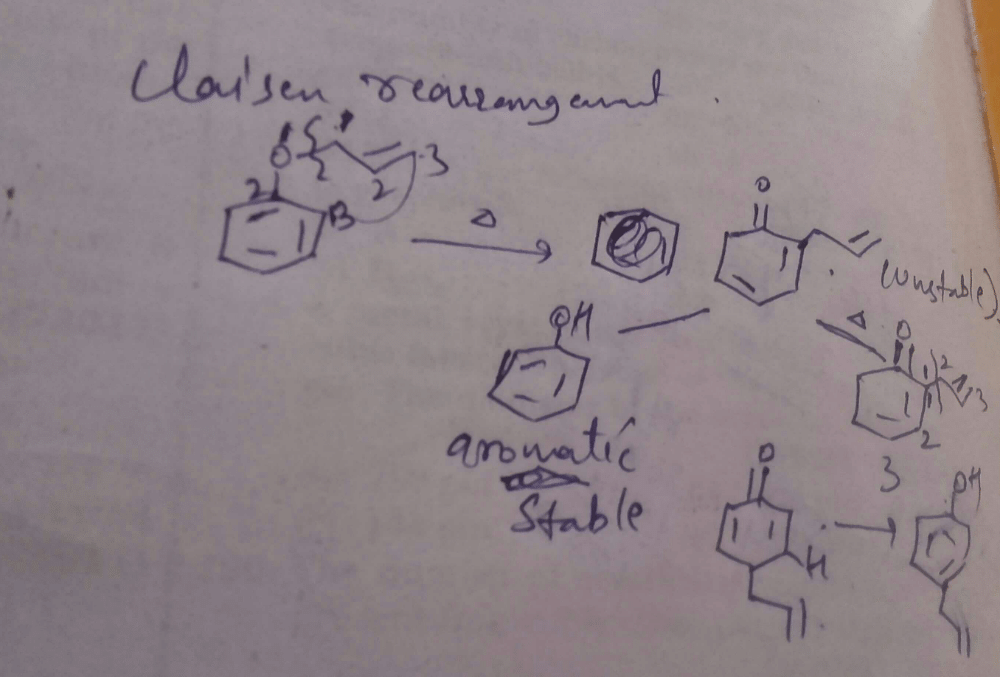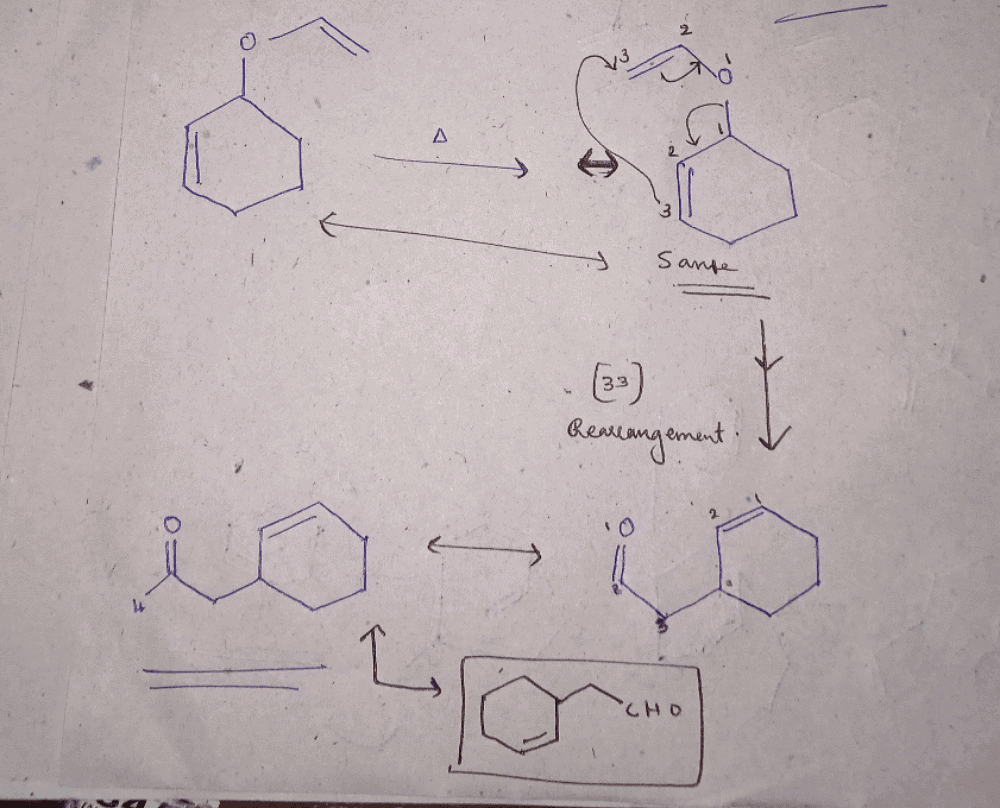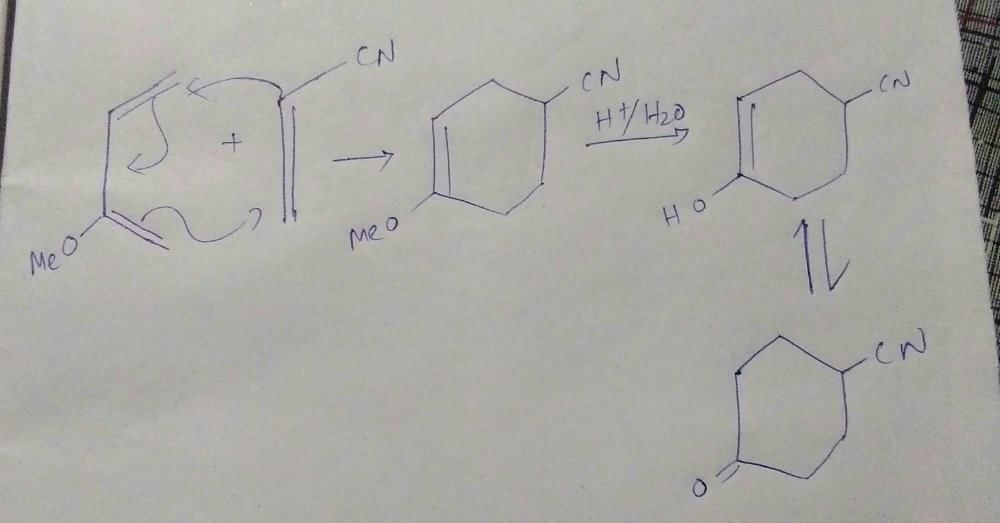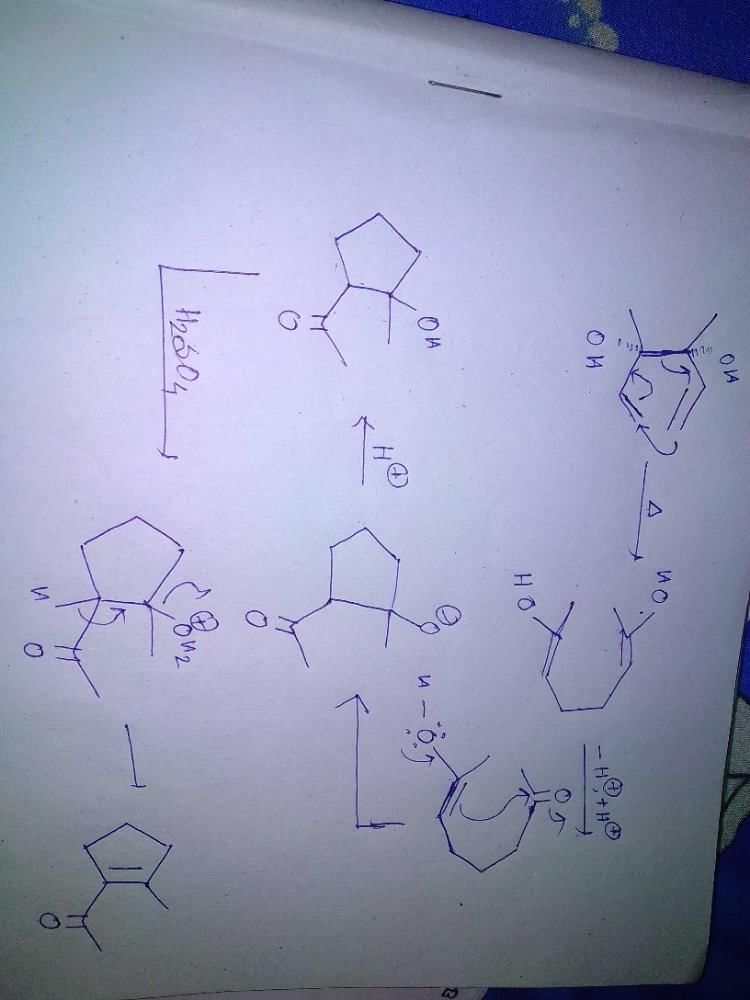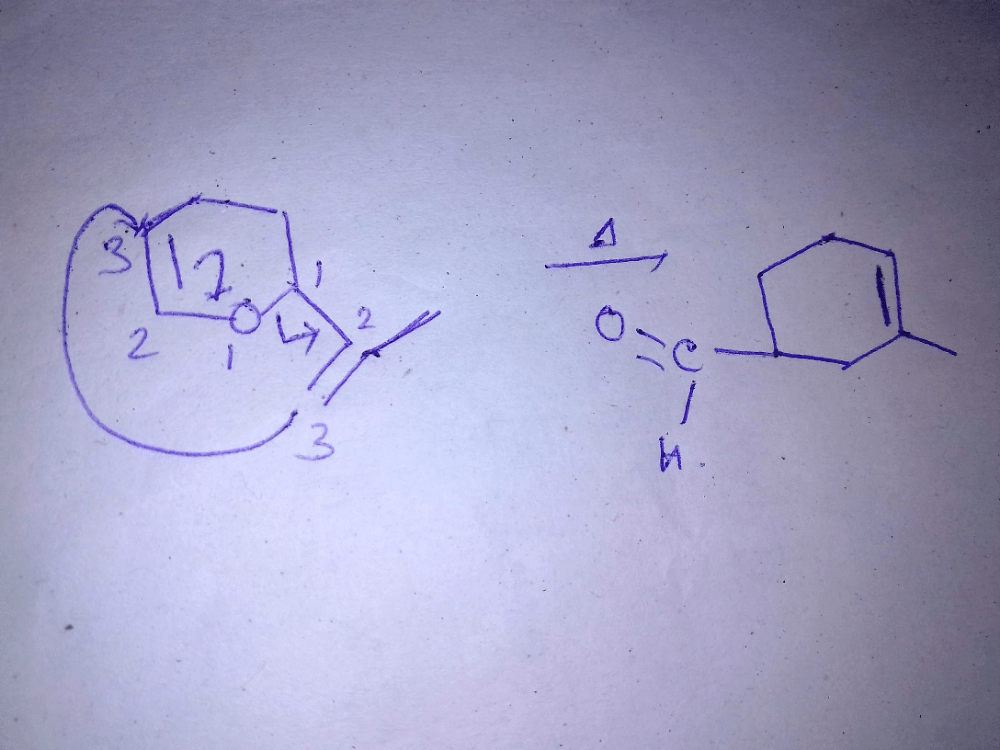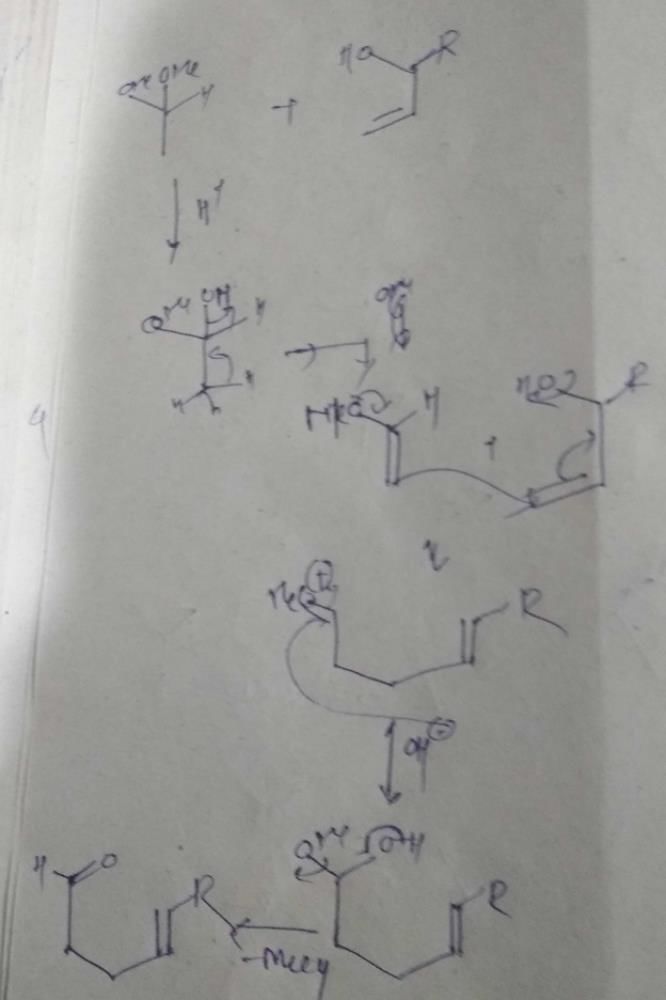All Exams >
Chemistry >
Topicwise Question Bank for IIT JAM/CSIR/GATE Chemistry >
All Questions
All questions of Pericyclic Reactions for Chemistry Exam
The major product of the following is: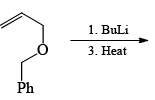
- a)

- b)

- c)

- d)

Correct answer is option 'D'. Can you explain this answer?
The major product of the following is:
a)
b)
c)
d)
|
|
Dronacharya Institute answered |
The Claisen rearrangement is a powerful carbon–carbon bond-forming chemical reaction discovered by Rainer Ludwig Claisen. The heating of an allyl vinyl ether will initiate a [3,3]-sigmatropic rearrangement to give a γ,δ-unsaturated carbonyl.


Can you explain the answer of this question below:The major product of the reaction is:
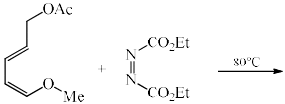
- A:
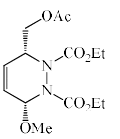
- B:
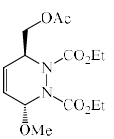
- C:

- D:
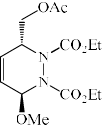
The answer is d.
The major product of the reaction is:

|
Parvathy Vs answered |
B and d are the same ryt!!...they just hav to be in opp stereo ...why is it d??
Order of reactivity of the following X, Y and Z in Diels-Alder reaction is:
- a)X > Z > Y
- b)Y > X > Z
- c)Y > Z > X
- d)X > Y > Z
Correct answer is option 'D'. Can you explain this answer?
Order of reactivity of the following X, Y and Z in Diels-Alder reaction is:
a)
X > Z > Y
b)
Y > X > Z
c)
Y > Z > X
d)
X > Y > Z

|
Shoaib Ali answered |
X is in cic position so react easily, Z is in trans position so first heat it and than Z react, so in between Z and Y 'Y react easily than Z, so option D correct
The most basic compound among the following is:-- a)Acetanilide
- b)Benzylamine
- c)p-Nitro aniline
- d)Aniline
Correct answer is option 'B'. Can you explain this answer?
The most basic compound among the following is:-
a)
Acetanilide
b)
Benzylamine
c)
p-Nitro aniline
d)
Aniline

|
Asf Institute answered |
Basicity is inversely proportional to resonance of lone pair electrons. Benzylamine is more basic. The electron pairs do not involve in resonance in benzylamine. In other amines, there is delocalization of lone pair of electron on N atom on the ring. In acetanilide, the delocalization of lone pair of electrons on N atom is due to adjacent CO group.
Hence option (B) is the answer.
Hence option (B) is the answer.
The number of nodes present in the highest occupied molecular orbital of 1, 3, 5-hexatiriene in its ground state in thermal conditions is:
- a)One
- b)Two
- c)Three
- d)Four
Correct answer is option 'B'. Can you explain this answer?
The number of nodes present in the highest occupied molecular orbital of 1, 3, 5-hexatiriene in its ground state in thermal conditions is:
a)
One
b)
Two
c)
Three
d)
Four

|
Athul Chaudhary answered |
Explanation:
1, 3, 5-hexatriene is a conjugated hydrocarbon molecule. The highest occupied molecular orbital (HOMO) is the molecular orbital with the highest energy level that is occupied by electrons. In the ground state, the electrons fill the molecular orbitals in order of increasing energy levels.
The HOMO of 1, 3, 5-hexatriene is a pi molecular orbital. The number of nodes present in this orbital can be determined using the following formula:
Number of nodes = (n - 1) - m
Where n is the total number of atomic orbitals that combine to form the molecular orbital and m is the number of nodal planes in the molecular orbital.
For the pi molecular orbital of 1, 3, 5-hexatriene, n = 6 (since there are six carbon atoms) and m = 2 (since there are two nodal planes). Therefore, the number of nodes in the pi molecular orbital of 1, 3, 5-hexatriene is:
(6 - 1) - 2 = 3
So the correct answer is option B, which states that there are two nodes present in the HOMO of 1, 3, 5-hexatriene.
1, 3, 5-hexatriene is a conjugated hydrocarbon molecule. The highest occupied molecular orbital (HOMO) is the molecular orbital with the highest energy level that is occupied by electrons. In the ground state, the electrons fill the molecular orbitals in order of increasing energy levels.
The HOMO of 1, 3, 5-hexatriene is a pi molecular orbital. The number of nodes present in this orbital can be determined using the following formula:
Number of nodes = (n - 1) - m
Where n is the total number of atomic orbitals that combine to form the molecular orbital and m is the number of nodal planes in the molecular orbital.
For the pi molecular orbital of 1, 3, 5-hexatriene, n = 6 (since there are six carbon atoms) and m = 2 (since there are two nodal planes). Therefore, the number of nodes in the pi molecular orbital of 1, 3, 5-hexatriene is:
(6 - 1) - 2 = 3
So the correct answer is option B, which states that there are two nodes present in the HOMO of 1, 3, 5-hexatriene.
The product of the following reaction is: 
- a)

- b)

- c)

- d)

Correct answer is option 'B'. Can you explain this answer?
The product of the following reaction is:
a)
b)
c)
d)

|
Nisha Yadav answered |
Electrocyclic 4n+2 reaction
Diels-Alder reaction normally yields endo-adduct as a major product. This is due to:- a) Higher stability of the product.
- b) Faster rate of formation of the endo product.
- c) Steric hindrance.
- d) Secondary orbital interactions between a diene and a dienophile.
Correct answer is option 'D'. Can you explain this answer?
Diels-Alder reaction normally yields endo-adduct as a major product. This is due to:
a)
Higher stability of the product.
b)
Faster rate of formation of the endo product.
c)
Steric hindrance.
d)
Secondary orbital interactions between a diene and a dienophile.

|
Saranya Mehta answered |
Introduction:
The Diels-Alder reaction is a powerful synthetic tool used to construct cyclic compounds. It involves the reaction between a conjugated diene and a dienophile to form a cyclic product known as the cycloadduct. In most cases, the major product obtained in the Diels-Alder reaction is the endo-adduct. This preference for the endo product can be explained by several factors.
Explanation:
1. Secondary orbital interactions:
The endo-adduct is favored due to the presence of secondary orbital interactions between the diene and dienophile. These interactions occur between the non-bonding electron pair on the diene and the empty orbital on the dienophile. This stabilizes the transition state leading to the formation of the endo product. The interaction is more favorable in the endo position compared to the exo position, leading to the preference for the endo-adduct.
2. Steric hindrance:
Steric hindrance also plays a role in determining the regioselectivity of the Diels-Alder reaction. The endo-product is often favored due to the lower steric hindrance in the transition state leading to its formation. The exo-product is hindered by the presence of bulky substituents that can lead to steric clashes, making the formation of the endo-product more favorable.
3. Stability of the product:
The endo-adduct is generally more stable than the exo-adduct due to the spatial arrangement of substituents. The endo-product often has substituents arranged in a more favorable conformation, leading to lower steric strain and increased stability. This stability contributes to the preference for the endo product in the Diels-Alder reaction.
4. Faster rate of formation:
In some cases, the endo-product may also be favored due to the faster rate of formation. The transition state leading to the endo-product may have a lower activation energy compared to the transition state leading to the exo-product. This kinetic preference can be attributed to a combination of factors, including orbital interactions and steric effects.
Conclusion:
In conclusion, the preference for the endo-adduct in the Diels-Alder reaction can be attributed to secondary orbital interactions, steric hindrance, stability of the product, and sometimes a faster rate of formation. These factors work together to determine the regioselectivity of the reaction, leading to the predominant formation of the endo product.
The Diels-Alder reaction is a powerful synthetic tool used to construct cyclic compounds. It involves the reaction between a conjugated diene and a dienophile to form a cyclic product known as the cycloadduct. In most cases, the major product obtained in the Diels-Alder reaction is the endo-adduct. This preference for the endo product can be explained by several factors.
Explanation:
1. Secondary orbital interactions:
The endo-adduct is favored due to the presence of secondary orbital interactions between the diene and dienophile. These interactions occur between the non-bonding electron pair on the diene and the empty orbital on the dienophile. This stabilizes the transition state leading to the formation of the endo product. The interaction is more favorable in the endo position compared to the exo position, leading to the preference for the endo-adduct.
2. Steric hindrance:
Steric hindrance also plays a role in determining the regioselectivity of the Diels-Alder reaction. The endo-product is often favored due to the lower steric hindrance in the transition state leading to its formation. The exo-product is hindered by the presence of bulky substituents that can lead to steric clashes, making the formation of the endo-product more favorable.
3. Stability of the product:
The endo-adduct is generally more stable than the exo-adduct due to the spatial arrangement of substituents. The endo-product often has substituents arranged in a more favorable conformation, leading to lower steric strain and increased stability. This stability contributes to the preference for the endo product in the Diels-Alder reaction.
4. Faster rate of formation:
In some cases, the endo-product may also be favored due to the faster rate of formation. The transition state leading to the endo-product may have a lower activation energy compared to the transition state leading to the exo-product. This kinetic preference can be attributed to a combination of factors, including orbital interactions and steric effects.
Conclusion:
In conclusion, the preference for the endo-adduct in the Diels-Alder reaction can be attributed to secondary orbital interactions, steric hindrance, stability of the product, and sometimes a faster rate of formation. These factors work together to determine the regioselectivity of the reaction, leading to the predominant formation of the endo product.
Consider the following statements:(I) Clasisen rearrangement is a [3, 3] sigmatropic rearrangement.
(II) Cope rearrangement proceeds via is chair like transition state.
(III) In the photochemical [2 + 2] cycloaddition of ethylene overlapping of HOMO of one molecule with LUMO of the other molecular takes place.Select the correct statements.- a)I and III
- b)II and III
- c)Only II
- d)I and II
Correct answer is option 'D'. Can you explain this answer?
Consider the following statements:
(I) Clasisen rearrangement is a [3, 3] sigmatropic rearrangement.
(II) Cope rearrangement proceeds via is chair like transition state.
(III) In the photochemical [2 + 2] cycloaddition of ethylene overlapping of HOMO of one molecule with LUMO of the other molecular takes place.
(II) Cope rearrangement proceeds via is chair like transition state.
(III) In the photochemical [2 + 2] cycloaddition of ethylene overlapping of HOMO of one molecule with LUMO of the other molecular takes place.
Select the correct statements.
a)
I and III
b)
II and III
c)
Only II
d)
I and II

|
Bijoy Patel answered |
Explanation:
Therefore, the correct option is 'D' - I and II.
- Claisen rearrangement: It is a [3, 3] sigmatropic rearrangement, which involves the migration of an allyl group from one oxygen atom to another oxygen atom, with the formation of a new carbon-carbon bond. Hence, statement I is correct.
- Cope rearrangement: It is a [3, 3] sigmatropic rearrangement, which involves the migration of a hydrocarbon group from one carbon atom to an adjacent carbon atom, with the formation of a new carbon-carbon bond. This reaction proceeds via a chair-like transition state. Hence, statement II is correct.
- Photochemical [2+2] cycloaddition: This reaction involves the formation of a cyclobutane ring from two molecules of ethylene under the influence of light. In this reaction, the highest occupied molecular orbital (HOMO) of one molecule overlaps with the lowest unoccupied molecular orbital (LUMO) of the other molecule. Hence, statement III is also correct.
Therefore, the correct option is 'D' - I and II.
In which of the following reaction, which sigmatropic reaction will take place:

- a) [1, 5] CH3 shift
- b) [1, 5] H shift
- c) [1, 3] CH3 shift
- d) [1, 3] H shift
Correct answer is option 'D'. Can you explain this answer?
In which of the following reaction, which sigmatropic reaction will take place:
a)
[1, 5] CH3 shift b)
[1, 5] H shift c)
[1, 3] CH3 shift d)
[1, 3] H shift

|
Yogendra Rajpoot answered |
Option b is correct because reaction is thermally take place and 1,3 hydrogen shifting takes place photochemically only and there is two time 1,5 hydrogen shifting takes place which take place thermally
The thermal ring opening reactions of cyclo butane are:- a)Conrotatory
- b)Disrotatory
- c)Conrotatory or disrotatory depending on the temperature at which reaction is carried
- d)Cannot be predicted
Correct answer is option 'A'. Can you explain this answer?
The thermal ring opening reactions of cyclo butane are:
a)
Conrotatory
b)
Disrotatory
c)
Conrotatory or disrotatory depending on the temperature at which reaction is carried
d)
Cannot be predicted

|
Anushka Chavan answered |
Thermal Ring Opening Reactions of Cyclo Butane
Introduction:
Cyclo butane is a cyclic alkane with four carbon atoms in a ring. It is known for its high ring strain due to its puckered structure. When cyclo butane undergoes a thermal ring opening reaction, the mechanism can either be conrotatory or disrotatory.
Conrotatory Mechanism:
In the conrotatory mechanism, the breaking of the sigma bonds in the ring occurs in a synchronous manner. This means that the two carbon-carbon sigma bonds on either side of the ring break at the same time, and the two resulting electrons move in the same direction. This leads to the formation of a planar intermediate with a pi bond. The pi bond then rotates, and the two carbon atoms on either side of the ring come closer together to form a new sigma bond. This results in the formation of an open-chain alkene.
Disrotatory Mechanism:
In the disrotatory mechanism, the breaking of the sigma bonds in the ring occurs in an asynchronous manner. This means that the two carbon-carbon sigma bonds on either side of the ring break at different times, and the two resulting electrons move in opposite directions. This leads to the formation of a twisted intermediate with two pi bonds. The pi bonds then rotate, and the two carbon atoms on either side of the ring move further apart to form two new sigma bonds. This results in the formation of an open-chain diene.
Temperature Dependence:
The mechanism of the thermal ring opening reaction of cyclo butane depends on the temperature at which the reaction is carried out. At high temperatures, the reaction is conrotatory, while at low temperatures, the reaction is disrotatory. This is due to the fact that the activation energy for the conrotatory mechanism is lower at high temperatures, while the activation energy for the disrotatory mechanism is lower at low temperatures.
Conclusion:
In conclusion, the thermal ring opening reaction of cyclo butane can occur via either a conrotatory or disrotatory mechanism, depending on the temperature at which the reaction is carried out. At high temperatures, the reaction is conrotatory, while at low temperatures, the reaction is disrotatory.
Introduction:
Cyclo butane is a cyclic alkane with four carbon atoms in a ring. It is known for its high ring strain due to its puckered structure. When cyclo butane undergoes a thermal ring opening reaction, the mechanism can either be conrotatory or disrotatory.
Conrotatory Mechanism:
In the conrotatory mechanism, the breaking of the sigma bonds in the ring occurs in a synchronous manner. This means that the two carbon-carbon sigma bonds on either side of the ring break at the same time, and the two resulting electrons move in the same direction. This leads to the formation of a planar intermediate with a pi bond. The pi bond then rotates, and the two carbon atoms on either side of the ring come closer together to form a new sigma bond. This results in the formation of an open-chain alkene.
Disrotatory Mechanism:
In the disrotatory mechanism, the breaking of the sigma bonds in the ring occurs in an asynchronous manner. This means that the two carbon-carbon sigma bonds on either side of the ring break at different times, and the two resulting electrons move in opposite directions. This leads to the formation of a twisted intermediate with two pi bonds. The pi bonds then rotate, and the two carbon atoms on either side of the ring move further apart to form two new sigma bonds. This results in the formation of an open-chain diene.
Temperature Dependence:
The mechanism of the thermal ring opening reaction of cyclo butane depends on the temperature at which the reaction is carried out. At high temperatures, the reaction is conrotatory, while at low temperatures, the reaction is disrotatory. This is due to the fact that the activation energy for the conrotatory mechanism is lower at high temperatures, while the activation energy for the disrotatory mechanism is lower at low temperatures.
Conclusion:
In conclusion, the thermal ring opening reaction of cyclo butane can occur via either a conrotatory or disrotatory mechanism, depending on the temperature at which the reaction is carried out. At high temperatures, the reaction is conrotatory, while at low temperatures, the reaction is disrotatory.
The major product of the reaction is:
- a)
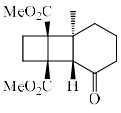
- b)
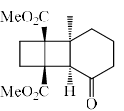
- c)
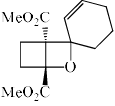
- d)No product formation
Correct answer is option 'B'. Can you explain this answer?
The major product of the reaction is:
a)
b)
c)
d)
No product formation
|
|
Madhumita Chakraborty answered |
Structure 1 reacts with structure 2 then we get structure B as major cause here Hydrogen placed on the below of atom hence hydrogen bonding is possible between oxygen and hydrogen O - H which is not possible in other cases thus why we get B as major product.
Hydrogen bonding is maximum in:
- a)Ethanol
- b)Ethyl chloride
- c)Diethyl ether
- d)Triethylamine
Correct answer is option 'A'. Can you explain this answer?
Hydrogen bonding is maximum in:
a)
Ethanol
b)
Ethyl chloride
c)
Diethyl ether
d)
Triethylamine

|
Shail Ghoshal answered |
Hydrogen bonding is maximum in ethanol.
Explanation:
What is hydrogen bonding?
Hydrogen bonding is a special type of intermolecular force that occurs between molecules containing hydrogen atoms bonded to highly electronegative elements such as oxygen, nitrogen, or fluorine. It is a strong dipole-dipole interaction that results in the formation of a partially positive hydrogen atom and a partially negative atom.
Factors affecting hydrogen bonding:
There are several factors that influence the strength of hydrogen bonding, including:
1. Electronegativity difference: The greater the electronegativity difference between hydrogen and the atom it is bonded to, the stronger the hydrogen bonding.
2. Size of the atom: Smaller atoms with higher electronegativity can form stronger hydrogen bonds.
3. Number of hydrogen bonding sites: The more hydrogen atoms bonded to electronegative atoms, the more hydrogen bonding sites are available.
4. Molecular shape: The presence of hydrogen bonding sites in a linear or planar arrangement increases the strength of hydrogen bonding.
Comparison of the given compounds:
a) Ethanol: Ethanol (CH3CH2OH) contains an -OH group, which can form hydrogen bonds. The electronegative oxygen atom attracts the hydrogen atom, resulting in the formation of strong hydrogen bonds between ethanol molecules.
b) Ethyl chloride: Ethyl chloride (CH3CH2Cl) does not contain any hydrogen bonding sites. The chlorine atom is not electronegative enough to form strong hydrogen bonds.
c) Diethyl ether: Diethyl ether (CH3CH2OCH2CH3) contains an oxygen atom, but it does not have any hydrogen bonding sites. The oxygen atom is not bonded to a hydrogen atom.
d) Triethylamine: Triethylamine (N(C2H5)3) does not contain any hydrogen bonding sites. Although it contains a nitrogen atom, it is not bonded to a hydrogen atom.
Conclusion:
Among the given compounds, ethanol has the maximum hydrogen bonding because it contains an -OH group, which can form strong hydrogen bonds. The other compounds do not have hydrogen bonding sites or have less electronegative atoms, resulting in weaker or no hydrogen bonding.
Explanation:
What is hydrogen bonding?
Hydrogen bonding is a special type of intermolecular force that occurs between molecules containing hydrogen atoms bonded to highly electronegative elements such as oxygen, nitrogen, or fluorine. It is a strong dipole-dipole interaction that results in the formation of a partially positive hydrogen atom and a partially negative atom.
Factors affecting hydrogen bonding:
There are several factors that influence the strength of hydrogen bonding, including:
1. Electronegativity difference: The greater the electronegativity difference between hydrogen and the atom it is bonded to, the stronger the hydrogen bonding.
2. Size of the atom: Smaller atoms with higher electronegativity can form stronger hydrogen bonds.
3. Number of hydrogen bonding sites: The more hydrogen atoms bonded to electronegative atoms, the more hydrogen bonding sites are available.
4. Molecular shape: The presence of hydrogen bonding sites in a linear or planar arrangement increases the strength of hydrogen bonding.
Comparison of the given compounds:
a) Ethanol: Ethanol (CH3CH2OH) contains an -OH group, which can form hydrogen bonds. The electronegative oxygen atom attracts the hydrogen atom, resulting in the formation of strong hydrogen bonds between ethanol molecules.
b) Ethyl chloride: Ethyl chloride (CH3CH2Cl) does not contain any hydrogen bonding sites. The chlorine atom is not electronegative enough to form strong hydrogen bonds.
c) Diethyl ether: Diethyl ether (CH3CH2OCH2CH3) contains an oxygen atom, but it does not have any hydrogen bonding sites. The oxygen atom is not bonded to a hydrogen atom.
d) Triethylamine: Triethylamine (N(C2H5)3) does not contain any hydrogen bonding sites. Although it contains a nitrogen atom, it is not bonded to a hydrogen atom.
Conclusion:
Among the given compounds, ethanol has the maximum hydrogen bonding because it contains an -OH group, which can form strong hydrogen bonds. The other compounds do not have hydrogen bonding sites or have less electronegative atoms, resulting in weaker or no hydrogen bonding.
The major product of the following is:

- a)

- b)

- c)

- d)

Correct answer is option 'A'. Can you explain this answer?
The major product of the following is:
a)
b)
c)
d)
|
|
Vedika Singh answered |
Six membered transition state of chair form will give option A.
In the [4 + 2] cycloaddition of 1, 3-butadiene and ethylene:- a)Overlap of the HOMO of butadiene with the LUMO of ethylene.
- b)Overlap of the HOMO of ethylene with the LUMO of butadiene.
- c)Both (a) and (b)
- d)None of these.
Correct answer is option 'C'. Can you explain this answer?
In the [4 + 2] cycloaddition of 1, 3-butadiene and ethylene:
a)
Overlap of the HOMO of butadiene with the LUMO of ethylene.
b)
Overlap of the HOMO of ethylene with the LUMO of butadiene.
c)
Both (a) and (b)
d)
None of these.

|
Bijoy Patel answered |
**Explanation:**
The [4 + 2] cycloaddition reaction between 1,3-butadiene and ethylene involves the overlap of the highest occupied molecular orbital (HOMO) of one reactant with the lowest unoccupied molecular orbital (LUMO) of the other reactant. Let's analyze the overlap of the HOMO and LUMO orbitals in this reaction:
**a) Overlap of the HOMO of butadiene with the LUMO of ethylene:**
- The HOMO of butadiene is a π molecular orbital, formed by the overlap of the p orbitals of the carbon atoms in the conjugated system. It consists of two nodal planes, with electron density both above and below the π system.
- The LUMO of ethylene is also a π molecular orbital, formed by the overlap of the p orbitals of the carbon atoms in the double bond. It consists of a single nodal plane in the middle of the π system, with electron density on either side of the plane.
- The overlap of the HOMO of butadiene with the LUMO of ethylene occurs when the π system of butadiene approaches the double bond of ethylene.
- The electron density in the HOMO of butadiene interacts with the electron-deficient region of the LUMO of ethylene, resulting in the formation of a new σ bond between the two reactants.
- This overlap leads to the formation of a cyclohexene derivative as the product of the [4 + 2] cycloaddition reaction.
**b) Overlap of the HOMO of ethylene with the LUMO of butadiene:**
- The HOMO of ethylene is also a π molecular orbital, formed by the overlap of the p orbitals of the carbon atoms in the double bond. It consists of a single nodal plane in the middle of the π system, with electron density on either side of the plane.
- The LUMO of butadiene is a π* molecular orbital, formed by the overlap of the p orbitals of the carbon atoms in the conjugated system. It also consists of two nodal planes, with electron density both above and below the π system.
- The overlap of the HOMO of ethylene with the LUMO of butadiene occurs when the double bond of ethylene approaches the π system of butadiene.
- However, this overlap does not lead to the formation of a new bond or the [4 + 2] cycloaddition product. Instead, it leads to a non-productive interaction between the two reactants.
**c) Both (a) and (b):**
- As discussed above, the overlap of the HOMO of butadiene with the LUMO of ethylene results in the formation of a new σ bond and the [4 + 2] cycloaddition product.
- On the other hand, the overlap of the HOMO of ethylene with the LUMO of butadiene does not lead to the formation of a new bond or the desired cycloaddition product.
- Therefore, the correct answer is option 'c' - both (a) and (b) - as the productive overlap occurs between the HOMO of butadiene and the LUMO of ethylene.
The [4 + 2] cycloaddition reaction between 1,3-butadiene and ethylene involves the overlap of the highest occupied molecular orbital (HOMO) of one reactant with the lowest unoccupied molecular orbital (LUMO) of the other reactant. Let's analyze the overlap of the HOMO and LUMO orbitals in this reaction:
**a) Overlap of the HOMO of butadiene with the LUMO of ethylene:**
- The HOMO of butadiene is a π molecular orbital, formed by the overlap of the p orbitals of the carbon atoms in the conjugated system. It consists of two nodal planes, with electron density both above and below the π system.
- The LUMO of ethylene is also a π molecular orbital, formed by the overlap of the p orbitals of the carbon atoms in the double bond. It consists of a single nodal plane in the middle of the π system, with electron density on either side of the plane.
- The overlap of the HOMO of butadiene with the LUMO of ethylene occurs when the π system of butadiene approaches the double bond of ethylene.
- The electron density in the HOMO of butadiene interacts with the electron-deficient region of the LUMO of ethylene, resulting in the formation of a new σ bond between the two reactants.
- This overlap leads to the formation of a cyclohexene derivative as the product of the [4 + 2] cycloaddition reaction.
**b) Overlap of the HOMO of ethylene with the LUMO of butadiene:**
- The HOMO of ethylene is also a π molecular orbital, formed by the overlap of the p orbitals of the carbon atoms in the double bond. It consists of a single nodal plane in the middle of the π system, with electron density on either side of the plane.
- The LUMO of butadiene is a π* molecular orbital, formed by the overlap of the p orbitals of the carbon atoms in the conjugated system. It also consists of two nodal planes, with electron density both above and below the π system.
- The overlap of the HOMO of ethylene with the LUMO of butadiene occurs when the double bond of ethylene approaches the π system of butadiene.
- However, this overlap does not lead to the formation of a new bond or the [4 + 2] cycloaddition product. Instead, it leads to a non-productive interaction between the two reactants.
**c) Both (a) and (b):**
- As discussed above, the overlap of the HOMO of butadiene with the LUMO of ethylene results in the formation of a new σ bond and the [4 + 2] cycloaddition product.
- On the other hand, the overlap of the HOMO of ethylene with the LUMO of butadiene does not lead to the formation of a new bond or the desired cycloaddition product.
- Therefore, the correct answer is option 'c' - both (a) and (b) - as the productive overlap occurs between the HOMO of butadiene and the LUMO of ethylene.
The major product of the following reaction is:
- a)

- b)

- c)

- d)

Correct answer is option 'B'. Can you explain this answer?
The major product of the following reaction is:
a)
b)
c)
d)

|
Uma Bharti answered |
Here 3 pi bond invlove...means 4n +2 system in con..in substrate both double bond is trans overall cis .con chnge in stereo so pdt gives trans stereo
The two step conversion of 7-dehydrocholesterol to vitamin D3 proceeds through: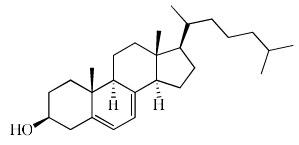
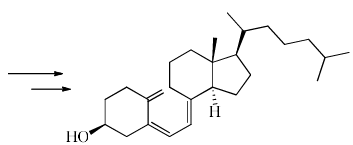
- a)Photochemical electrocyclic disrotatory ring opening; and thermal antarafacial [1, 7]- H shift.
- b)Photochemical electrocyclic conrotatory ring opening; and thermal antarafacial [1, 7]- H shift.
- c)Thermal electrocyclic conrotatory ring opening; and photochemical superafacial [1, 7]-H shift.
- d)Thermal electrocyclic disrotatory ring opening; and thermal superafacial [1, 7]-H shift.
Correct answer is option 'B'. Can you explain this answer?
The two step conversion of 7-dehydrocholesterol to vitamin D3 proceeds through:
a)
Photochemical electrocyclic disrotatory ring opening; and thermal antarafacial [1, 7]- H shift.
b)
Photochemical electrocyclic conrotatory ring opening; and thermal antarafacial [1, 7]- H shift.
c)
Thermal electrocyclic conrotatory ring opening; and photochemical superafacial [1, 7]-H shift.
d)
Thermal electrocyclic disrotatory ring opening; and thermal superafacial [1, 7]-H shift.
|
|
Ananya Kumari answered |
The two the number of step by the equal is to give
and prosperity and give to me electronic and to line and emerge,
photochemical electrocyclic conrotatory ring
opening, and thermal antarafacial 1,7 minus h shift ans
and prosperity and give to me electronic and to line and emerge,
photochemical electrocyclic conrotatory ring
opening, and thermal antarafacial 1,7 minus h shift ans
The major product of the following reaction is:
- a)

- b)

- c)

- d)

Correct answer is option 'A'. Can you explain this answer?
The major product of the following reaction is:
a)
b)
c)
d)

|
Chelsi Mehta answered |
3-3 Sigmatropic Reaction
(Pericyclic)
(Pericyclic)
Which of the following dienes cannot undergo Diels-Alder reactions?- a)

- b)

- c)

- d)

Correct answer is option 'B'. Can you explain this answer?
Which of the following dienes cannot undergo Diels-Alder reactions?
a)

b)

c)

d)


|
Asf Institute answered |
To determine which diene cannot undergo a Diels-Alder reaction, we analyze the structure of each compound. A Diels-Alder reaction requires a conjugated diene in an s-cis conformation to react with a dienophile.
- Option (a): This is a conjugated diene, and it can adopt the s-cis conformation, making it capable of undergoing a Diels-Alder reaction.
- Option (b): This is a cyclic conjugated diene locked in the s-cis conformation. Since the geometry is already suitable, it can undergo a Diels-Alder reaction.
- Option (c): This is benzene, an aromatic compound. Benzene does not act as a diene in a Diels-Alder reaction because it is not reactive due to its aromatic stability.
- Option (d): This is an open-chain conjugated diene. It can adopt the s-cis conformation, so it is capable of undergoing a Diels-Alder reaction.
Conclusion:
The diene that cannot undergo a Diels-Alder reaction is option (c) because benzene is aromatic and does not react as a diene.
Correct Answer: (c).
The reaction given below is an example of:
- a)1, 3-sigmatropic hydrogen shift.
- b)1, 3-sigmatropic methyl shift.
- c)1, 5-sigmatropic hydrogen shift.
- d)1, 5-sigmatropic methyl shift.
Correct answer is option 'C'. Can you explain this answer?
The reaction given below is an example of:
a)
1, 3-sigmatropic hydrogen shift.
b)
1, 3-sigmatropic methyl shift.
c)
1, 5-sigmatropic hydrogen shift.
d)
1, 5-sigmatropic methyl shift.

|
Aj Prasad answered |
In thermal condition [1,5] sigmatropic hydrogen only possible
Diels-Alder reaction is a:- a)[2 + 2] Thermal cyclisation.
- b)[4 + 2] Photoaddition.
- c)[4 + 2] Cycloaddition.
- d)[3 + 3] Cycloaddition.
Correct answer is option 'C'. Can you explain this answer?
Diels-Alder reaction is a:
a)
[2 + 2] Thermal cyclisation.
b)
[4 + 2] Photoaddition.
c)
[4 + 2] Cycloaddition.
d)
[3 + 3] Cycloaddition.

|
Nandini Das answered |
Understanding the Diels-Alder Reaction
The Diels-Alder reaction is a fundamental chemical reaction in organic chemistry, particularly in the formation of cyclic compounds.
What is the Diels-Alder Reaction?
- It is a [4 + 2] cycloaddition reaction.
- Involves a diene (a molecule with two double bonds) and a dienophile (a molecule with a double bond) reacting to form a six-membered cyclic product.
Key Features of the Reaction
- Mechanism:
- The reaction proceeds through a concerted mechanism, meaning that the bond-making and bond-breaking occur simultaneously.
- Stereochemistry:
- The reaction is stereospecific, allowing for the retention of stereochemistry in the reactants in the products.
Thermal vs. Photoinduced Reactions
- The Diels-Alder reaction typically occurs under thermal conditions (heat).
- It is not a photoaddition, as it does not require light to proceed.
Applications
- Widely used in the synthesis of complex organic molecules, including natural products and pharmaceuticals.
- Valuable for its ability to construct six-membered rings efficiently.
Conclusion
The Diels-Alder reaction's classification as a [4 + 2] cycloaddition highlights its role in forming cyclic structures through the interaction of diene and dienophile. This reaction is crucial in the field of organic synthesis due to its efficiency and versatility.
The Diels-Alder reaction is a fundamental chemical reaction in organic chemistry, particularly in the formation of cyclic compounds.
What is the Diels-Alder Reaction?
- It is a [4 + 2] cycloaddition reaction.
- Involves a diene (a molecule with two double bonds) and a dienophile (a molecule with a double bond) reacting to form a six-membered cyclic product.
Key Features of the Reaction
- Mechanism:
- The reaction proceeds through a concerted mechanism, meaning that the bond-making and bond-breaking occur simultaneously.
- Stereochemistry:
- The reaction is stereospecific, allowing for the retention of stereochemistry in the reactants in the products.
Thermal vs. Photoinduced Reactions
- The Diels-Alder reaction typically occurs under thermal conditions (heat).
- It is not a photoaddition, as it does not require light to proceed.
Applications
- Widely used in the synthesis of complex organic molecules, including natural products and pharmaceuticals.
- Valuable for its ability to construct six-membered rings efficiently.
Conclusion
The Diels-Alder reaction's classification as a [4 + 2] cycloaddition highlights its role in forming cyclic structures through the interaction of diene and dienophile. This reaction is crucial in the field of organic synthesis due to its efficiency and versatility.
The reaction is given below is an example of:
- a)[1, 3] Sigmatropic shift.
- b)[2, 3] Sigmatropic shift.
- c)[1, 5] Sigmatropic shift.
- d)[3, 3] Sigmatropic shift.
Correct answer is option 'D'. Can you explain this answer?
The reaction is given below is an example of:
a)
[1, 3] Sigmatropic shift.
b)
[2, 3] Sigmatropic shift.
c)
[1, 5] Sigmatropic shift.
d)
[3, 3] Sigmatropic shift.
|
|
Shuvajyoti Sarkar answered |
This is an example of cope rearrangement reaction.In cope rearrangement [3,3] sigmatropic shift occurs.
In the reaction sequence, the major products X and Y, respectively are:
- a)

- b)
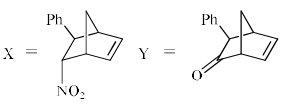
- c)

- d)
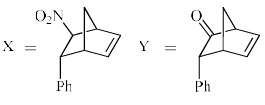
Correct answer is option 'B'. Can you explain this answer?
In the reaction sequence, the major products X and Y, respectively are:
a)
b)
c)
d)

|
Jyoti Sharma answered |
This is NEF reaction in second step
The major product of the following reaction is:
- a)

- b)

- c)

- d)

Correct answer is option 'A'. Can you explain this answer?
The major product of the following reaction is:
a)
b)
c)
d)
|
|
Surbhi Pareek answered |
Cycloaddition rex is stereo specific so trans gives trans opetion A is correct
The major product X and Y formed in the following reaction sequence are:
- a)

- b)

- c)

- d)

Correct answer is option 'A'. Can you explain this answer?
The major product X and Y formed in the following reaction sequence are:
a)
b)
c)
d)

|
Jyoti Sharma answered |
In second step hydrogenolysis occur
Chapter doubts & questions for Pericyclic Reactions - Topicwise Question Bank for IIT JAM/CSIR/GATE Chemistry 2025 is part of Chemistry exam preparation. The chapters have been prepared according to the Chemistry exam syllabus. The Chapter doubts & questions, notes, tests & MCQs are made for Chemistry 2025 Exam. Find important definitions, questions, notes, meanings, examples, exercises, MCQs and online tests here.
Chapter doubts & questions of Pericyclic Reactions - Topicwise Question Bank for IIT JAM/CSIR/GATE Chemistry in English & Hindi are available as part of Chemistry exam.
Download more important topics, notes, lectures and mock test series for Chemistry Exam by signing up for free.

Contact Support
Our team is online on weekdays between 10 AM - 7 PM
Typical reply within 3 hours
|
Free Exam Preparation
at your Fingertips!
Access Free Study Material - Test Series, Structured Courses, Free Videos & Study Notes and Prepare for Your Exam With Ease

 Join the 10M+ students on EduRev
Join the 10M+ students on EduRev
|

|
Create your account for free
OR
Forgot Password
OR
Signup to see your scores
go up within 7 days!
Access 1000+ FREE Docs, Videos and Tests
Takes less than 10 seconds to signup

